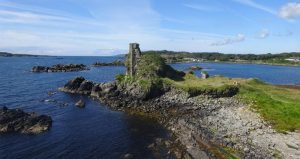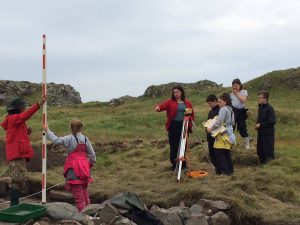On Tuesday 27th of August the whole school went to Dunyvaig to contribute in a archaeology dig . A kind lady called Sophie was are  tour guide showing us all the stations, for some stations examples there was a digging in the trench, photography and looking at findings and lots more.
tour guide showing us all the stations, for some stations examples there was a digging in the trench, photography and looking at findings and lots more.
Personally I think that everyone loved the digging the most because the pride of finding some thing is just amazing but it was probably because we got to get dirty on a school day! But when I was digging I was the only one who found something from p6/7 and I found a broken part off a clay pigeon. When we were at the photography station we got to use a professional camera and are group made silly videos and I videoed it because I don’t like cameras.
But the last thing my group did was my favorite we got to hold and see all the artifacts from last year and this year. My favorite thing was the half a cannon ball they thought that it was from a attack when clan Donald attacked Dunyvaig. And another cool thing from last year was a stamp with a name and date on it. And their most recent find was a broach from the 17th century.  Then sadly the day had to end.
Then sadly the day had to end.
By Caitidh










 On Wendnesday 29th August we went on a bus to go to Finlaggan. When we got there our class was the first to go and see all of the old buildings and island in the middle of the Loch. When we were finished outside we went inside to see a lot of old things that the Lords of the Isles would use and other things they used in the medieval times and the family tree of one of the familys that lived there and facts about Finlaggan. When we were done that we got back on the bus but the bus was leaking oil so we had to drive to mundells yard to get a new bus and came back to school.
On Wendnesday 29th August we went on a bus to go to Finlaggan. When we got there our class was the first to go and see all of the old buildings and island in the middle of the Loch. When we were finished outside we went inside to see a lot of old things that the Lords of the Isles would use and other things they used in the medieval times and the family tree of one of the familys that lived there and facts about Finlaggan. When we were done that we got back on the bus but the bus was leaking oil so we had to drive to mundells yard to get a new bus and came back to school.
 On Monday 20th August we went to Dunyvaig. We met Darko Markovic who showed us around the site. First he showed us a burned down house, which they said might have been used for fighting.
On Monday 20th August we went to Dunyvaig. We met Darko Markovic who showed us around the site. First he showed us a burned down house, which they said might have been used for fighting.